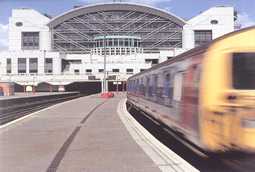| enginuity |
|
Rumble in the urban jungle
Vibrations from underground railways in many of the world's major cities are often at unacceptable levels for residential apartments. Although the idea of isolating buildings from ground-transmitted vibrations has been around for years (the first to be built in this way was the Grand Central station in New York in 1915), the effectiveness of the products used has not significantly increased since their introduction.

Embankment Place station, which is built on rubber anti-vibration pads supplied by Tiflex Ltd. Photo courtesy of Greycoats Plc and Ove Arup & Partners.
Interactions
Dr Hugh Hunt explains: 'Buildings, tunnels and tracks have always been regarded as behaving as rigid bodies, as far as transmission of ground vibrations is concerned.'
'Using this type of model, the transmission of ground vibrations should be attenuated by more than 80% if a rubber-based resilient foundation is used to reduce the natural frequency of the building to less than a third of the disturbing frequency. In fact, it is almost certain that the vibrations from tunnels and track interact, and it is important to include this complex effect in any model of the system. Buildings aren't rigid, and vibrations cause tunnels to deform, with bulges moving along their length, producing a similar effect to a snake swallowing its prey.' Dr Hunt's team is currently working on producing computer models which can be used to optimise the designs of tracks, tunnels and buildings, to cut out unwanted vibrational noise. 'A trial-and-error approach to reducing the effect of ground vibration not only does not work, but is also far too expensive,' says Dr Hunt.
Interdependent changes
'We are using a combination of computational modelling, measurement of material properties and on-site measurements to optimise the performance of anti-vibration products and future building designs. In my view, vibration control can only be improved through radical and interdependent changes to the design of tracks, tunnels and buildings. This will undoubtedly create difficulties, but there are always compromises that can be made.' As more urban rail networks are planned, including the imminent channel tunnel rail link, it is hoped that commercially available design aids will be available in the next couple of years.
Enquiries to Dr Hugh Hunt Tel: (01223) 332730
| number 6, summer '97 |